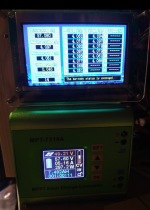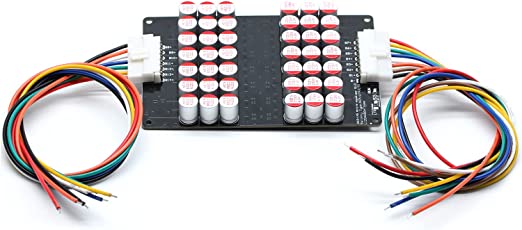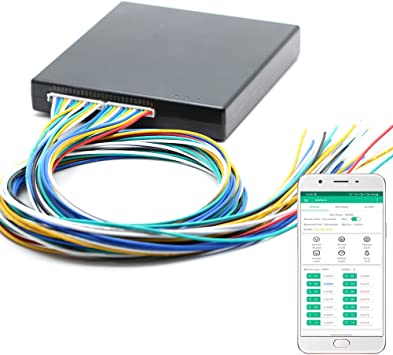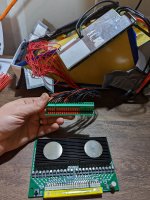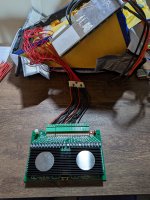Kimchi said:
I might have missed something, how are active cell balancer to be used?
I have the same balancer and monitor as this guy.
https://youtu.be/WKGk5Of4sik
But I also have a charger attached as well.
The usefulness of that 5A Active Balancer (
https://youtu.be/WKGk5Of4sik) and others like it are IMO more for a low drain ebike battery of questionable cells and low drain powerbanks of salvaged cells (even different brands) that have been tested and sorted with approximately the same capacity, internal resistance and MCD amp rating. So as to makeup parallel groups that are as similar as possible to each other (as in that youtube).
In that youtube
the best Active 5amp Balancing of that 14s10p battery of salvaged cells
after several hours was 0.047V. However, after disconnecting that 5amp Active Balancer the 14 parallel groups returned to an imbalance of 0.134V. That's typical of a battery pack made up of
salvaged cells varying in brand, IR, MCD amp rating and possibly chemistry (e.g. NCA, NMC). Cells that were free or at most no more than 50¢ each.
The point being that the best p-group balancing possible for that 14s10p battery (at rest) was 134mV. That's assuming the capacites, IR, etc are as similar as possible so say out of 200 salvaged cells that were tested 140 cells were usable. 134mV is not bad assuming the application is more mild-mannered amp drain rather than power/speed amp requirement.
A p-group variance of 150mV may be no problem with a low amperage powerbank application using that $60 5A Active Balancer Board shown in the youtube you posted ...
You could purchase a better Active Balancer that will balance the p-groups within 5mV, but WHY if the best cell grouping (p-group variance) of salvaged cells is 134mV. For all practical purposes it's probably a waste of money to purchase this Active Balancer ...
https://www.amazon.com/Equalizer-Balancer-Equalization-Precision-Capacitor/dp/B09ZDSDQ7C/ref=pd_lpo_2?pd_rd_i=B09ZDSDQ7C&psc=1 ...
https://www.aliexpress.us/item/3256802957321281.html?_randl_currency=USD&src=google&src=google&albch=shopping&acnt=708-803-3821&slnk=&plac=&mtctp=&albbt=Google_7_shopping&albagn=888888&isSmbAutoCall=false&needSmbHouyi=false&albcp=9594035441&albag=102695258807&trgt=296904913880&crea=en3256802957321281&netw=u&device=c&albpg=296904913880&albpd=en3256802957321281&gclid=CjwKCAjwv4SaBhBPEiwA9YzZvABeMIDJrk93f2pqby6RYL3kTVmQwBbP3mV1pmkCa-Tc8mV65VNz6BoCuhEQAvD_BwE&gclsrc=aw.ds&aff_fcid=c00d4e16f2524d1bb39e401a22362f05-1665272200883-00870-UneMJZVf&aff_fsk=UneMJZVf&aff_platform=aaf&sk=UneMJZVf&aff_trace_key=c00d4e16f2524d1bb39e401a22362f05-1665272200883-00870-UneMJZVf&terminal_id=3131f10fdae84e7bb972df5102b44d3f&afSmartRedirect=y&gatewayAdapt=glo2usa&_randl_shipto=US ...
If an ebike DIY build of salvaged cells are almost identical you may want to invest in a more expensive Active Balancer with digital readout of the parallel groups that can be balanced within a few millivolts of each other whether after discharging before charging or after charging before discharging (as needed). However, if the salvaged cell variance (Brand, Capacity, IR, MCD amp rating and Cell Chemistry) is such that balancing even within 50mV is not possible with the other 5A Active Balancer than even the best Active (equalizing) Balancer will only be able to equalize the resting p-group voltages after hours and hours, if even then.
Kimchi said:
Are you guys doing it separately?
With a DIY ebike battery build (e.g. 13s10p) if possible buy overstocked unused cells 3-5 years old for $2 (same name brand, same manufacturing run, same capacity, same IR, same MCD rating, same chemistry). That was the case with my $2 cells ...
https://batteryhookup.com/products/30-100-new-samsung-inr18650-33g-3150mah-18650-cells. After the first dozen c/d cycles the parallel groups are still within 5mV of each other both after discharge and after charge ... so no need to balance the parallel groups (yet) ...
https://batteryhookup.com/products/30-100-new-samsung-inr18650-33g-3150mah-18650-cells
So no need to manually bottom balance after discharging or manually top balance after charging. Even when that becomes necessary i prefer manually balancing because it is considerably faster than using an Active Balancer Board. IMO an Active Balancer Board is OK for a low drain powerbank or ebike battery of salvaged cells, but not an amp thirsty ebike battery unless it's like 10p with more thaan enuf p-group amperage to handle the Controller rated amp drain for a couple minutes.


